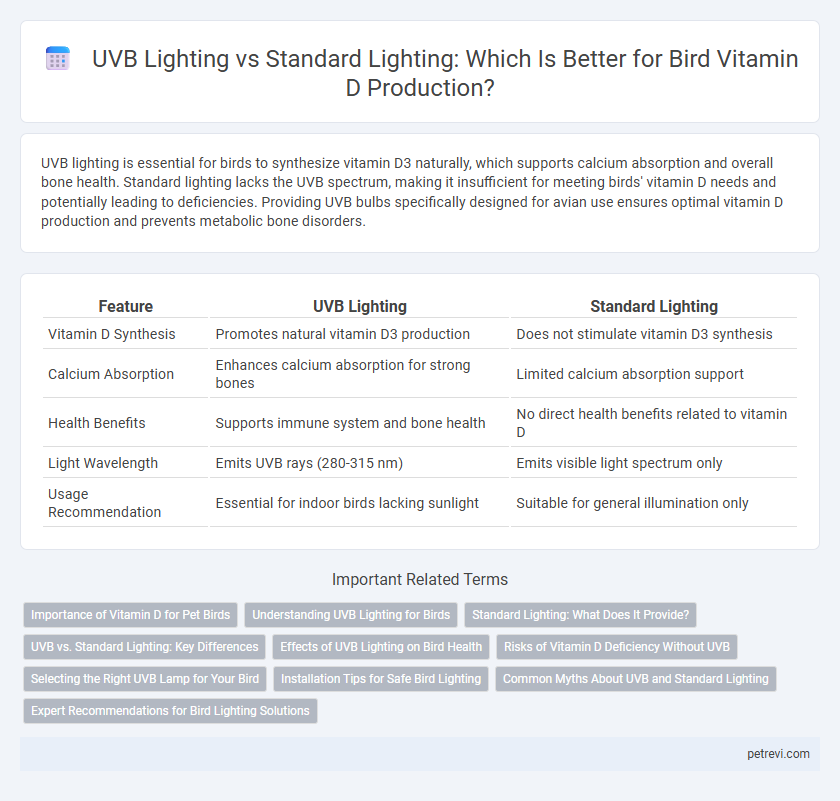UVB lighting is essential for birds to synthesize vitamin D3 naturally, which supports calcium absorption and overall bone health. Standard lighting lacks the UVB spectrum, making it insufficient for meeting birds' vitamin D needs and potentially leading to deficiencies. Providing UVB bulbs specifically designed for avian use ensures optimal vitamin D production and prevents metabolic bone disorders.
Table of Comparison
| Feature | UVB Lighting | Standard Lighting |
|---|---|---|
| Vitamin D Synthesis | Promotes natural vitamin D3 production | Does not stimulate vitamin D3 synthesis |
| Calcium Absorption | Enhances calcium absorption for strong bones | Limited calcium absorption support |
| Health Benefits | Supports immune system and bone health | No direct health benefits related to vitamin D |
| Light Wavelength | Emits UVB rays (280-315 nm) | Emits visible light spectrum only |
| Usage Recommendation | Essential for indoor birds lacking sunlight | Suitable for general illumination only |
Importance of Vitamin D for Pet Birds
UVB lighting is crucial for pet birds as it enables the synthesis of vitamin D3, essential for calcium absorption and bone health. Standard lighting lacks the specific wavelengths needed to stimulate this process, potentially leading to deficiencies and metabolic bone disease. Providing adequate UVB exposure supports immune function, feather quality, and overall vitality in pet birds.
Understanding UVB Lighting for Birds
UVB lighting plays a crucial role in enabling birds to synthesize vitamin D3, which is essential for calcium absorption and overall bone health. Standard lighting lacks the specific UVB spectrum necessary for this process, making it insufficient for maintaining optimal vitamin D levels in captive birds. Understanding the difference between UVB and standard lighting helps ensure birds receive proper exposure to prevent deficiencies and support their metabolic functions.
Standard Lighting: What Does It Provide?
Standard lighting provides essential visible light that supports a bird's natural circadian rhythm, but it lacks the ultraviolet B (UVB) rays necessary for synthesizing vitamin D3 in the skin. Without UVB exposure, birds cannot effectively convert dietary calcium, leading to potential deficiencies such as bone weakness and metabolic disorders. While standard lighting maintains general visibility and behavior, it does not fulfill the critical role of UVB in promoting optimal vitamin D metabolism and overall avian health.
UVB vs. Standard Lighting: Key Differences
UVB lighting emits ultraviolet B rays essential for avian synthesis of vitamin D3, which supports calcium absorption and bone health, unlike standard lighting that lacks these rays. Birds exposed to UVB lighting naturally produce vitamin D3, reducing risks of deficiencies such as metabolic bone disease. Standard lighting can illuminate environments but does not trigger the biochemical processes necessary for optimal vitamin D metabolism in birds.
Effects of UVB Lighting on Bird Health
UVB lighting significantly enhances vitamin D3 synthesis in birds, promoting calcium absorption essential for bone development and eggshell quality. Standard lighting lacks the specific UVB spectrum, which can lead to vitamin D deficiency, resulting in metabolic bone disease and weakened immune responses. Incorporating UVB lamps mimics natural sunlight, improving overall bird health, vitality, and feather condition.
Risks of Vitamin D Deficiency Without UVB
Without UVB lighting, birds face significant risks of vitamin D deficiency, leading to weakened bones, impaired calcium absorption, and compromised immune function. Standard lighting lacks the UVB spectrum necessary for birds to synthesize vitamin D3 naturally, making supplementation through UVB exposure crucial. Chronic deficiency can result in metabolic bone disease, decreased egg production, and increased susceptibility to infections in captive birds.
Selecting the Right UVB Lamp for Your Bird
Selecting the right UVB lamp for your bird is crucial to ensure proper vitamin D3 synthesis, which supports calcium metabolism and bone health. Full-spectrum UVB bulbs emitting wavelengths between 290 to 320 nm are ideal for mimicking natural sunlight and promoting the production of vitamin D3 in a bird's skin. Regularly replacing UVB lamps every 6 to 12 months maintains optimal UVB output, as standard lighting lacks the necessary UVB spectrum critical for avian health.
Installation Tips for Safe Bird Lighting
Installing UVB lighting for bird vitamin D synthesis involves positioning the light at an optimal distance, typically 12-18 inches from the bird's habitat, to ensure effective UVB exposure without causing burns. Use full-spectrum UVB bulbs designed for avian species, replacing them every 6-12 months due to diminishing UVB output despite visible light. Avoid glass or plastic barriers which block UVB rays, and incorporate timers to regulate exposure, mimicking natural sunlight cycles and preventing overexposure that can lead to health issues.
Common Myths About UVB and Standard Lighting
UVB lighting is essential for birds to synthesize vitamin D3 effectively, which supports calcium metabolism and bone health, contrary to the myth that standard lighting provides adequate UVB exposure. Many believe that indirect sunlight or regular indoor lights can replace UVB bulbs, but these sources lack the specific wavelengths necessary for vitamin D synthesis. Misunderstandings about UVB safety and necessity often lead to inadequate lighting choices, risking vitamin D deficiency and related health issues in pet birds.
Expert Recommendations for Bird Lighting Solutions
Expert recommendations emphasize UVB lighting as essential for birds to synthesize vitamin D3 effectively, which is crucial for calcium metabolism and bone health. Standard lighting lacks the specific UVB spectrum necessary to trigger this natural process, often leading to deficiencies and related health issues. Avian specialists advocate UVB lamps with appropriate intensity and duration for optimal bird vitamin D synthesis and overall well-being.
UVB lighting vs Standard lighting for Bird vitamin D Infographic

 petrevi.com
petrevi.com